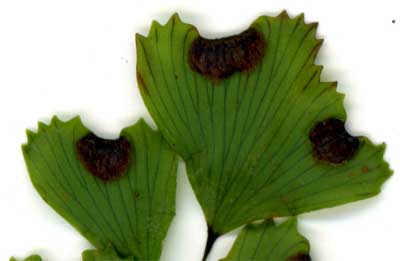|
Hardy Fern Home A. monochlamys resources
All Ferns � Pteridaceae �� Adiantum
�Other Genera
|
| Adiantum monochlamys | ||
|
Etymology
Mono signifies single; chlamys recalls a kind of cloak worn by the ancient Greeks.
Description
Rhizome: short-creeping, 4 mm diam., clump-forming, scales linear to linear-lanceolate, dark brown.
Frond: 40 cm high by 8 cm wide, deciduous, monomorphic, blade/stipe ratio: 3:2. Stipe: purplish brown to reddish brown, polished, scaly at base, glabrous in upper portion, 2 mm diam., vascular bundles: 1 or 2. Blade: 2-pinnate most commonly, but more at the base in mature specimens, ovate, with a terminal pinna similar to the terminal pinnules of the pinnae, papery, glabrous. Pinnae: 4 to 6 pair, lanceolate, to 4 cm, anadromous in plan; pinnules wedge-shaped, to 12 mm; margins toothed at the far end; veins free, palmate. Sori: oblong, mostly solitary in the center of the upper margin of the pinnule, indusium: false, inrolled margins, reniform, sporangia: reddish-brown. Culture
Habitat: dry cliffs or rocky slopes in open forests.
Distribution: Japan, China, Korea.
Hardy to -20�C, USDA Zone 6.
Distinctive Characteristics
The single sorus�may not�be unique in the genus, but it is among temperate ferns.
Synonyms
Adiantum venustum var. monochlamys (Eaton) Luerss. Adiantum veitchii Hance |
|
|

Adiantum monochlamys. The one-sorus-per-segment rule is sometimes invalid on the terminal segment (pinnule). �Scan: Tom Stuart |
